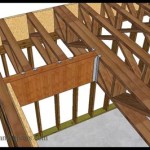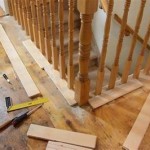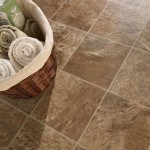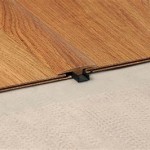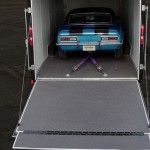Removing Glued Down Wood Flooring From Concrete
Removing wood flooring that has been glued directly to a concrete subfloor is a challenging yet often necessary task. Whether the aim is to replace damaged flooring, install a different material, or address underlying moisture issues, understanding the process and potential difficulties is crucial for a successful outcome. The adhesive used in these installations creates a strong bond, making removal significantly more complex than simply lifting the flooring. This article provides a detailed guide to removing glued-down wood flooring from concrete, covering preparation, tools, techniques, and safety considerations.
The first step in removing glued-down flooring is assessing the scope of the project. Consider the size of the area, the type of adhesive used (if known), and the condition of the concrete subfloor. A thorough assessment will help determine the best removal methods and the necessary tools and materials. Furthermore, a preliminary inspection can reveal potential problems, such as asbestos-containing adhesives (common in older installations) or pre-existing damage to the concrete slab. If asbestos is suspected, professional testing and abatement are essential before proceeding with any removal work. Ignoring this step could lead to serious health consequences.
Before beginning any physical removal work, proper preparation of the workspace is essential. This involves clearing furniture, protecting adjacent surfaces, and ensuring adequate ventilation. Cover nearby walls and trim with plastic sheeting to prevent damage from tools and flying debris. Open windows and doors to improve airflow, especially if using solvents or adhesives removers, as these products can release harmful fumes. It is also advisable to turn off the HVAC system to prevent the spread of dust and odors throughout the building. Personal protective equipment (PPE) is not an option, but a necessity.
The correct tools are essential for efficient and safe removal of glued-down wood flooring. A scraper, whether manual or powered, is the primary tool for lifting the flooring. A manual floor scraper, which resembles a large chisel with a long handle, is effective for smaller areas and detailed work. For larger areas, a powered floor scraper, also known as a floor stripper, can significantly reduce the amount of time and effort required. Additional tools that may be needed include a pry bar, hammer, chisel, utility knife, circular saw (for cutting the flooring into manageable sections), vacuum cleaner, and adhesive remover.
The removal process typically involves a combination of techniques, depending on the type of flooring, the strength of the adhesive bond, and the condition of the concrete subfloor. One approach is to cut the flooring into smaller sections using a circular saw. This makes it easier to pry up individual pieces, reducing the overall force required and minimizing the risk of damaging the concrete. Set the saw blade depth to match the thickness of the flooring, avoiding cutting into the concrete. Wear safety glasses and a dust mask when using power tools to protect against flying debris and dust inhalation.
Key Point 1: Softening the Adhesive
One of the most effective strategies for removing glued-down flooring is to soften the adhesive. This can be accomplished through various methods, including applying heat, solvents, or specialized adhesive removers. Heat guns can be used to warm the adhesive, making it more pliable and easier to scrape away. Exercise caution when using a heat gun, as excessive heat can damage the flooring or the concrete. Aim for a moderate temperature and keep the heat gun moving to avoid overheating any one area.
Solvents such as mineral spirits or acetone can also be used to soften the adhesive. Apply the solvent to the flooring, allowing it to penetrate the adhesive layer for a set period, generally specified by the product manufacturer. Always test the solvent in an inconspicuous area first to ensure it does not damage the flooring or the concrete. Ensure the area is well-ventilated when using solvents, and wear appropriate gloves and a respirator to protect against harmful fumes and skin contact.
Specialized adhesive removers are specifically formulated to break down the bond between the flooring and the concrete. These products are often water-based or citrus-based and may be less hazardous than traditional solvents. Follow the manufacturer's instructions carefully when using adhesive removers, as application methods and dwell times can vary. After applying the remover, allow it to sit for the recommended period before attempting to scrape away the flooring.
When dealing with stubborn adhesives, a combination of methods may be necessary. For example, heat can be used to soften the adhesive, followed by the application of a solvent or adhesive remover to further weaken the bond. Experiment with different approaches to find the most effective solution for the specific type of adhesive used in the installation.
Key Point 2: Utilizing Manual and Powered Scraping Tools
Whether using a manual or powered scraper, the technique is similar: apply force to the flooring, working to separate it from the adhesive layer. With a manual floor scraper, position the blade at a low angle to the floor and use a hammer or mallet to drive the blade under the flooring. Work in small sections, gradually lifting the flooring as you proceed. Be careful not to apply excessive force, as this can damage the concrete or cause the scraper to slip.
A pry bar can be helpful for lifting stubborn sections of flooring. Insert the pry bar under the flooring and gently apply leverage to break the adhesive bond. Use a piece of wood or other protective material between the pry bar and the concrete to prevent damage to the subfloor. Work slowly and deliberately to avoid cracking or chipping the concrete.
Powered floor scrapers can significantly speed up the removal process, especially for large areas. These machines use a vibrating or oscillating blade to loosen the flooring from the concrete. Follow the manufacturer's instructions carefully when operating a powered floor scraper. Wear hearing protection and eye protection, as these machines can be noisy and generate a lot of dust and debris. Start with a low blade angle and gradually increase it as needed to effectively remove the flooring.
Regardless of the tool used, maintaining a sharp blade is essential for efficient removal. A dull blade will require more force, increasing the risk of damaging the concrete or causing injury. Sharpen the scraper blade regularly using a file or sharpening stone, or replace disposable blades as needed. A sharp blade will cut more easily through the adhesive, making the removal process faster and safer.
Key Point 3: Addressing Adhesive Residue and Concrete Repair
After the flooring has been removed, adhesive residue will almost inevitably remain on the concrete subfloor. Removing this residue is essential for ensuring proper adhesion of any new flooring material. Various methods can be used to remove adhesive residue, including mechanical scraping, chemical stripping, and grinding.
Mechanical scraping involves using a floor scraper or chisel to manually remove the adhesive residue. This method is effective for small areas or for removing large chunks of adhesive. Use caution to avoid damaging the concrete subfloor. Chemical stripping involves applying an adhesive remover to soften the residue, followed by scraping. Choose an adhesive remover that is compatible with the type of adhesive used in the original installation. Follow the manufacturer's instructions carefully, and ensure adequate ventilation.
Concrete grinding is a more aggressive method for removing adhesive residue. This involves using a concrete grinder equipped with a diamond grinding wheel to remove a thin layer of the concrete surface, along with the adhesive residue. Concrete grinding is effective for removing stubborn residue and for creating a smooth, level surface for new flooring. Wear respiratory protection and eye protection when grinding concrete, as this process generates a lot of dust. Consider using a grinder with a dust collection system to minimize dust exposure.
Once the adhesive residue has been removed, inspect the concrete subfloor for any damage, such as cracks, holes, or unevenness. Repair any damage before installing new flooring. Small cracks can be filled with a concrete patching compound. Larger cracks may require more extensive repair, such as the application of a crack isolation membrane. Fill holes with a self-leveling concrete patch. Use a straightedge to ensure the surface is level and smooth. Allow the patching compound to cure completely before proceeding with the installation of new flooring.
Proper disposal of the removed flooring, adhesive residue, and any solvents or adhesive removers is essential. Check local regulations for guidelines on disposing of these materials. Some materials may be considered hazardous waste and require special disposal methods. Contact your local waste management authority for more information. Store solvents and adhesive removers in tightly sealed containers in a well-ventilated area, away from heat and open flames.
Safety should always be the top priority when removing glued-down wood flooring from concrete. Wear appropriate personal protective equipment, including safety glasses, a dust mask or respirator, gloves, and hearing protection, as needed. Ensure adequate ventilation, especially when using solvents or adhesive removers. Use caution when operating power tools, and follow the manufacturer's instructions carefully. Take breaks as needed to avoid fatigue, and work in a well-lit area to minimize the risk of accidents. By following these safety precautions, the risk of injury can be significantly reduced.

Wood Floor Removal Glued Down Jbl Flooring

How To Remove Glued Wood Flooring Easy Diy Steps Faqs And Abbotts At Home

Removing Glued Down Wood Floor From Concrete

How To Remove Glued Wood Flooring Easy Diy Steps Faqs And Abbotts At Home

How To Remove Glued Wood Flooring Easy Diy Steps Faqs And Abbotts At Home

How To Remove Glued Wood Flooring Easy Diy Steps Faqs And Abbotts At Home

How To Remove Glued Wood Flooring And Engineered On Concrete

How To Remove Adhesive From Concrete Floors 6 Ways Glue Abbotts At Home

Removing Engineered Hardwood Glued Directly To Concrete Phoenix Scottsdale Gilbert Peoria Arizona

How To Remove Adhesive From Concrete Floors 6 Ways Glue Abbotts At Home
Related Posts

